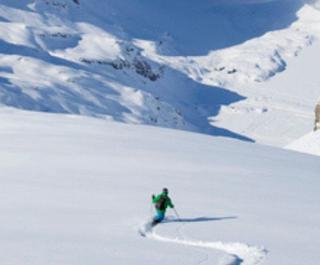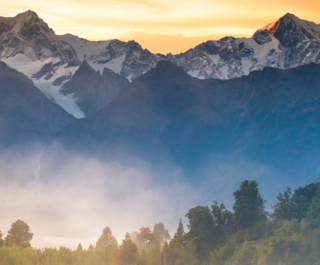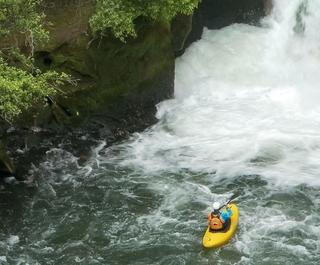
To say I’ve just had the best night’s sleep ever may be a brash claim, but staying in a cave has its perks. Forget sleeping in the great outdoors, I’m simply doing what the locals in Coober Pedy do – living underground. After a solid 10 hours at The Desert Cave Hotel, it’s time to see what riches South Australia’s quirky Outback town has to offer.
From The Scenic Lookout, Coober Pedy is a sprawl of hotchpotch structures and rusty metalwork, its barren landscape dotted with mounds of orange dirt; the only tree crafted from rusty wrought iron. No wonder the filmmakers of Priscilla and Mad Max Beyond Thunderdome were drawn here.
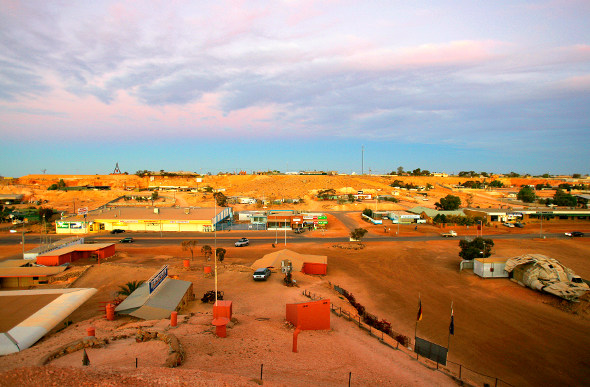 The sprawling Outback town of Coober Pedy. Picture: Getty Images
The sprawling Outback town of Coober Pedy. Picture: Getty Images
The mounds are mullock heaps, grubby excrement of the town's opal-mining industry. A century ago, discovery of these precious rainbow gems transformed the area into a mining Mecca. One early adopter had the bright idea to use a cavern carved from rock to escape the 40C+ summer heat. Not only was it the first dugout home but it earned the town its name – 'kupa piti' in the local Aboriginal language means 'white man’s hole'.
Life Underground
Today’s dugout abodes are vastly improved, thanks to modern tunnelling equipment that makes light work of the chunky limestone geology. More than half of the 3,000 residents live down below. The resultant landscape is one of near-endless burrows distinguished only by protruding ventilation shafts.
Faye’s Underground Home was constructed in the 1930s by the eponymous Faye and typical of most dugouts, it’s tunnelled into the hillside with street-level entrance and windows. With a rabbit-warren feel, its low-hanging ceilings and rough-to-the-touch walls pair with domestic trappings to create a comfortable home, albeit a dark one. Walls are plastered white or retain their natural rose colour, sealed with clear varnish to accentuate the tunnelled patterns.
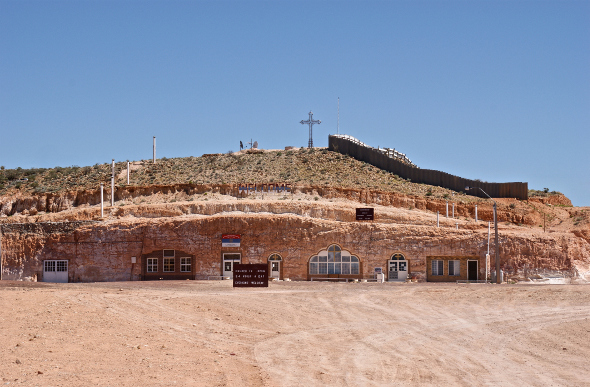 The unorthodox underground Serbian Orthodox Church. Picture: Getty Images
The unorthodox underground Serbian Orthodox Church. Picture: Getty Images
There’s something to be said for underground living. There are no loud neighbours, no need to paint and when space gets tight, simply carve out a new room – or, as in Faye’s case, a swimming pool.
Locals didn’t stop at underground homes – there’s an underground art gallery, bookshop, campsite and three churches. The Serbian Orthodox Church, with a 10-metre high domed roof, stained-glass windows and intricately patterned walls, is stunning.
More South Australia inspiration:
Head out of the city: Top 10 Day Trips From Adelaide
Stunning backdrop: Wild Encounter On The Coorong
Opals & Oddities
Sustenance comes courtesy of John’s Pizza Restaurant and the surprisingly tasty trucker-sized offerings, before opal fever takes over. The Old Timer’s Mine was mysteriously filled in and abandoned by its miners around 1916.
Rediscovered in 1968, when neighbours excavated their home, the meandering tunnels are a museum run by the opal-crazy Trevor Berry. Like many residents, Trevor’s also an opal miner, cheerily regaling visitors with fossicking stories before tempting buyers with his gem collection.
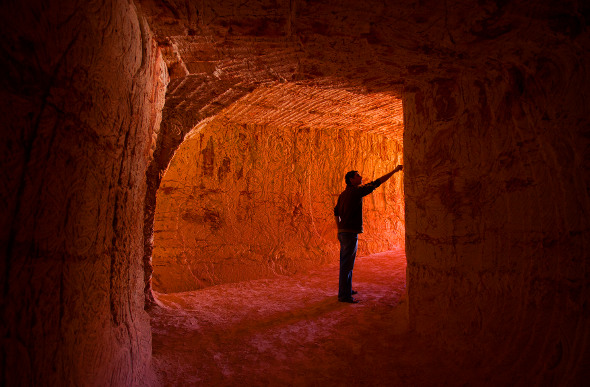 Tunnels criss-cross Coober Pedy. Picture: Getty Images
Tunnels criss-cross Coober Pedy. Picture: Getty Images
Forty-plus countries are represented in Coober Pedy and the unique cultural mix gives dining a distinctive ethnic flair not often found in the Outback. Spoilt for choice, we enjoy friendly service and Greek-inspired dining at The Underground Cafe.
Day two sees another unique experience at the Opal Fields Golf Club, with its crushed rock fairways, dry creek bunkers and greens fashioned from coarse black sand oiled to glue it down. Teeing off on a piece of artificial grass, we conquer a scorching and windy 18-hole circuit.
An indulgent dinner at Umberto’s leads to an impromptu drive beyond the bleed of the town’s light pollution and to nowhere. Looking up at the dazzling brightness of the stars and the backdrop of the dark Outback sky, there’s a priceless beauty that outstrips any opal seen so far.
Coupled with one last underground sleep, we realise we can truly say we struck it lucky in Coober Pedy.


